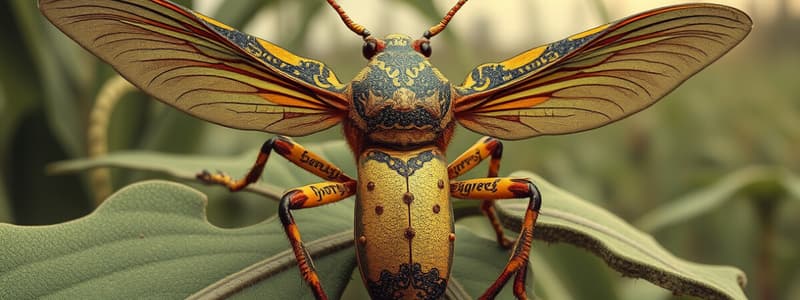Podcast
Questions and Answers
What is the primary challenge in storing maize highlighted in the study?
What is the primary challenge in storing maize highlighted in the study?
The primary challenge is the infestation by the maize weevil (Sitophilus zeamais).
Which treatment was found to be the most effective against Sitophilus zeamais?
Which treatment was found to be the most effective against Sitophilus zeamais?
Treatment C3 was found to be the most effective.
How many weevils were alive in treatment C1 after 7 days?
How many weevils were alive in treatment C1 after 7 days?
After 7 days, 8.0 weevils were alive in treatment C1.
What starting condition was common across all treatments on Day 1?
What starting condition was common across all treatments on Day 1?
What recommendations were proposed based on the findings of the study?
What recommendations were proposed based on the findings of the study?
What was the highest mortality rate treatment recorded in the study?
What was the highest mortality rate treatment recorded in the study?
What is the primary aim of using B.bassiana in the study?
What is the primary aim of using B.bassiana in the study?
From where were the soil samples collected for this study?
From where were the soil samples collected for this study?
At what depth were the soil samples taken during the study?
At what depth were the soil samples taken during the study?
Why is understanding environmental conditions important for B.bassiana's performance?
Why is understanding environmental conditions important for B.bassiana's performance?
Study Notes
Introduction
- Maize (Zea mays L.) is the most produced staple crop globally, with 1.16 billion metric tons estimated in 2020.
- The maize weevil (Sitophilus zeamais) presents significant storage challenges for maize.
Aim
- Objective: To evaluate the efficacy of Beauveria bassiana as a biocontrol agent against S. zeamais in stored maize in Ghana.
Materials and Methods
- Soil samples for culturing B. bassiana were collected from Donyina, KNUST Botanical Gardens, and Kotei at a 15cm depth.
- Samples transported to the KNUST Microbiology lab, sieved, diluted, and cultured on PDA for 7 days.
- Microscopic examination confirmed the presence of hyphae and oval cells.
- Bioassays conducted using collected S. zeamais weevils, applying harvested and diluted conidia to sterile filter paper.
- Mortality and survival of weevils monitored over a 7-day period with statistical analysis revealing significant differences by Day 6 and Day 7.
Results
- Initial setup: All treatments (C1, C2, C3) started with 10 S. zeamais weevils each.
- Day 7 outcomes for alive weevils:
- C1: 8.0 weevils, C2: 6.6 weevils, C3: 5.4 weevils remaining.
- Treatment C3 demonstrated the highest efficacy, showing notable mortalities.
- Significant mortality by Day 7:
- C1: 2.0 deaths, C2: 3.4 deaths, C3: 4.6 deaths.
Conclusion
- B. bassiana effectively reduces populations of S. zeamais, leading to lower damage to stored maize.
- Higher concentrations of B. bassiana spores correlate with increased weevil mortality and require prolonged exposure for effective pest control.
- The importance of environmental conditions in enhancing B. bassiana efficacy for biocontrol strategies is underscored.
Recommendations
- Enhance guidelines for environmental management that foster fungal growth to maximize effectiveness against S. zeamais.
- Further research needed on how varying environmental factors affect B. bassiana performance and pest control strategies.
Studying That Suits You
Use AI to generate personalized quizzes and flashcards to suit your learning preferences.
Related Documents
Description
This quiz assesses the use of Beauveria bassiana as a biocontrol agent against the maize weevil, Sitophilus zeamais, in stored maize in Ghana. It covers the methodology, including soil sample collection, culturing processes, and bioassay results. Test your knowledge on this study and its implications for maize storage and pest management.

